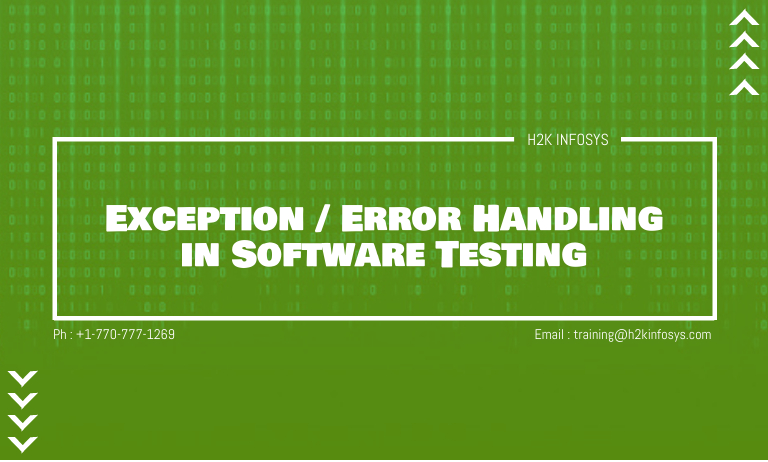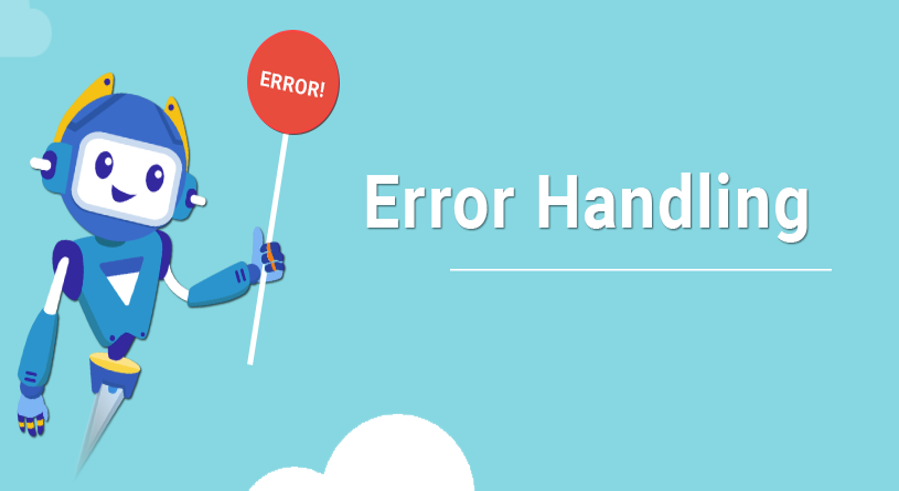Introduction
In the world of software testing, exception and error handling are critical aspects that ensure the resilience, reliability, and smooth functioning of applications. Software testers encounter diverse challenges, including unexpected inputs, hardware malfunctions, and unhandled exceptions. Understanding how to effectively manage these issues is crucial in quality assurance (QA). In this guide, we’ll explore error handling in-depth, provide practical examples, and discuss how Quality Assurance Software Testing Courses with essential skills to tackle real-world software challenges.
Error handling in software testing ensures that a system gracefully manages unexpected issues. By identifying and resolving errors, testers can prevent system crashes, data loss, and security vulnerabilities. Effective error handling improves overall software reliability, ensuring a smoother user experience and reducing potential risks in production environments.
What is Exception and Error Handling in Software Testing?
Exception and error handling refers to identifying, managing, and resolving unexpected situations in software applications. This process involves catching unforeseen errors, ensuring they don’t disrupt user experience, and implementing robust handling mechanisms. Exception handling aims to minimize disruptions by guiding applications through abnormal conditions gracefully.
Why is Exception Handling Important in Quality Assurance?
Ensuring System Stability
In a dynamic software environment, unforeseen errors are inevitable. Without proper exception handling, these errors could lead to crashes, freezes, or unintended behavior, potentially rendering the software unusable. A well-implemented exception-handling mechanism ensures that such errors are caught and managed effectively, allowing the application to recover or fail gracefully without compromising system stability.
Protecting User Experience
A smooth user experience is a cornerstone of quality software. When exceptions occur, a user-friendly error message or fallback mechanism can prevent users from becoming frustrated or losing trust in the application. For instance, if a payment system encounters an error, a clear message explaining the issue and offering alternative actions can maintain user confidence.
Identifying Root Causes Quickly
Proper exception handling includes logging detailed information about errors, such as the time, location, and context of their occurrence. This information is invaluable for developers and QA teams as it simplifies debugging and root cause analysis, allowing for quicker resolution of issues.
Enhancing System Security
Insecure or unhandled exceptions can expose sensitive information or create vulnerabilities that hackers could exploit. For example, an unhandled exception might display system-level details in error messages, providing attackers with insights into the application’s architecture. Robust exception handling minimizes these risks by securely managing errors and safeguarding critical data.
Supporting Continuous Delivery and Deployment
In modern development practices like DevOps, where continuous integration and continuous delivery (CI/CD) are central, exception handling becomes vital. Automated testing pipelines rely on well-defined error-handling mechanisms to identify failures during development or deployment stages. This ensures that errors are addressed promptly without disrupting the release cycle.
Meeting Compliance and Quality Standards
For industries governed by strict regulatory requirements such as healthcare, finance, and aviation proper exception handling is non-negotiable. QA processes must demonstrate that software applications can handle exceptions without compromising data integrity or compliance with standards. This is particularly important during audits or certifications.
Aligning with QA Objectives
Quality Assurance is not just about finding bugs but also about ensuring the overall resilience of a system. Exception handling directly supports QA objectives by addressing potential failure points and reinforcing the robustness of the application. This alignment ensures that the end product is both high-quality and user-ready.
Enabling Automation in Testing
Automated testing plays a significant role in modern QA processes. Exception handling facilitates automation by providing clear outcomes for edge cases and failures. Test scripts can be designed to verify the system’s response to exceptions, ensuring that the application behaves as expected under adverse conditions.
Error Handling in Software Testing
Software testing plays a critical role in ensuring the quality, reliability, and performance of an application. However, even with a meticulous testing process, certain challenges and limitations are inevitable. Among these, error handling and the inherent limitations of testing processes stand out. Let’s dive deeper into these aspects to understand their impact on software development and how they can be addressed.
The Challenges of Error Handling in Software Testing
Error handling in software testing refers to identifying, documenting, and managing unforeseen issues that may arise during the testing or post-deployment phases. While software testing aims to eliminate bugs, error handling becomes critical when unexpected scenarios occur. Here are some common challenges:
- Unpredictable User Behavior
- Test cases are typically designed for expected user behaviors. However, real-world users can interact with the software in unpredictable ways, uncovering edge cases that testers didn’t consider.
- Environment Differences
- Testing environments often differ from production environments. Variances in hardware, network conditions, and third-party integrations can introduce errors that were not encountered during testing.
- Incomplete Test Coverage
- Achieving 100% test coverage is nearly impossible. Certain scenarios, such as rare user inputs or unusual data combinations, might not be tested, leaving room for errors to surface later.
The Limitations of Software Testing
No matter how rigorous the software testing process, certain limitations exist. These limitations highlight the importance of a robust error-handling strategy to mitigate risks during production.
1. Bias in Test Case Design
Testers, being human, carry inherent biases in software testing. They design test cases based on assumptions about user behavior, often overlooking scenarios that seem unlikely but could occur in real-world usage.
2. Infinite User Scenarios
In software testing, it’s impractical to test every possible combination of user actions, inputs, and system states. For example, thousands of users might access your application simultaneously in ways you never anticipated. This scale and diversity of interaction can reveal issues that testing environments could not simulate.
3. Resource and Time Constraints
In software testing, testing processes are often bound by strict deadlines and limited resources, which can lead to prioritizing certain test cases over others. This trade-off increases the likelihood of untested scenarios causing errors in production.
The Impact of Unforeseen Errors
1. User Experience Degradation
Unforeseen errors, when encountered by end users, can disrupt their experience. For instance, a bug might prevent a user from completing a critical transaction, leading to dissatisfaction and loss of trust.
2. Increased Maintenance Costs
Errors discovered in production are typically costlier to fix than those found during the testing phase. They may also require emergency patches and updates, straining development resources.
3. Reputation Risks
Errors in live systems can damage the reputation of a brand, especially if the issues are critical or widely reported by users.
Addressing the Limitations with Better Error Handling
Although it’s impossible to eliminate all errors, certain strategies can minimize their impact and ensure a smoother user experience.
1. Embracing Real-World Testing Scenarios
Incorporate real-world scenarios into your testing process. Use tools like load testing and stress testing to simulate high-traffic conditions and uncover potential bottlenecks.
2. Implementing Automated Testing
Automated testing tools can help identify errors in repetitive scenarios and improve coverage. This leaves testers free to focus on complex, creative test cases.
3. User Feedback Mechanisms
Encourage users to report issues through clear feedback mechanisms. This allows teams to quickly identify and fix errors that were missed during testing.
4. Continuous Testing and Monitoring
Adopt a continuous testing approach where testing is performed throughout the development lifecycle. Post-deployment, use monitoring tools to track system performance and error logs in real time.
The Role of Testing in Error Prevention
While testing cannot eliminate all errors, it remains a crucial line of defense in software development. By acknowledging its limitations and complementing it with robust error-handling strategies, teams can build more resilient systems.
Balancing Testing and Error Handling
Testing identifies issues during development, but error handling ensures that unforeseen problems do not derail the user experience. Together, they form a comprehensive approach to delivering high-quality software.
Preparing for the Unexpected
Despite rigorous testing, the dynamic and unpredictable nature of real-world usage ensures that errors will occur. Acknowledging the limitations of testing is the first step toward effective error management.
What is the differences between Errors and Exceptions
Programming errors are those where there’s no chance to recover or continue gracefully and typically need programmer to return and alter the code to fix it. Errors can be turned into exceptions so that they can be handled within the code. Errors can usually be avoided with simple checks and if simple checks won’t suffice errors can also turn into exceptions so that applications can handle the situations gracefully.
Exceptions
Take advantage of language-specific semantics and present when something exceptional has happened. Exceptions are thrown and caught therefore the code can recover and handle the situations and not enter a mistake state. This also lets the application can recover or continue. Where unhandled exceptions can also be logged so they are looked at by developer to fix the underlying error.
Error handling testing is a type of software testing that is done to check whether the system is capable of or able to handle errors that may happen in future. This type of testing is done with the help of both developers and testers. Error handling testing not only focuses on the determination of error but also focuses on the exception handling.
Objectives of Error Handling Testing:
- It checks the system ability to handle errors.
- It checks the system highest soak point
- To make sure errors can be well managed by the system in the future.
- The system is capable of exception handling also.
The different steps in error handling are:
- Test environment setup- Test environment is set based on the software testing technique so that the testing process can run smoothly. This step includes planning for testing. System will be tested to make sure to have less significant data as there may be crash problem in the system during testing.
- Test case generation- software testing test case generation is making different test cases which may cause error. Suppose a software which operates on fractions then setting the denominator of fractions as zero.
- Test case execution- After the execution of the test case, its result is analysed. It includes the checking of the inconsistency in the expected output for generated test case.
- Result and Analysis- When the test case is executed, its result is analysed. It includes the checking of the inconsistency in the expected output generated test case.
- Re-test– If the testing is failed then analysis of all the above steps is done to test the system.
Key Takeaways
- Exception Handling is Crucial: Effective error handling is vital for reliable applications.
- Use Specific Error Types: Avoid generic exceptions to increase accuracy and clarity.
- Centralize Error Management: Streamlined, consistent error handling across modules prevents confusion and improves debugging.
- Hands-on Practice is Essential: Real-world experience in handling exceptions is invaluable for a successful QA career.
Conclusion
Mastering exception and error handling is a foundational skill for anyone in Quality Assurance Software Testing. From implementing try-catch blocks to using advanced logging techniques, a robust understanding of error management prepares software testers to build reliable, user-friendly applications. Our Software Testing and Quality Assurance Course at H2K Infosys is designed to provide in-depth, hands-on training in error handling and other core QA skills.
Ready to elevate your QA skills? Enroll in Quality assurance tester training Courses today and learn how to manage exceptions like a pro with real-world, industry-relevant training.



























7 Responses
It checks for the system ability to handle errors and makes sure and it can be well managed in future. The system is capable of exception handling also. First, a test environment is setup. A test case is generated and executed. Result is analysed and retested. If the testing is failed, analysis of all the above steps is done to test the system. It makes the software ready for all circumstances.
Main objective of error handling is to check whether the system is capable of or able to handle errors that may happen in future. Error handling testing not only focuses on the determination of error but also focuses on the exception handling.
Objectives of Error Handling Testing:
-It checks the system ability to handle errors.
-It checks the system highest soak point
-To make sure errors can be well managed by the system in the future.
-The system is capable of exception handling also.
Objectives of Error Handling Testing:
-It checks the system ability to handle errors.
-It checks the system highest soak point
-To make sure errors can be well managed by the system in the future.
-The system is capable of exception handling also.
Error handling testing is a type of software testing that is performed to check whether the system is capable of or able to handle the errors that may happen in the future. Error handling testing not only focuses on the determination of error but also focuses on exception handling.
Error handling testing is a type of software testing that is done to check whether the system is capable of or able to handle errors that may happen in future. This type of testing is done with the help of both developers and testers. Error handling testing not only focuses on the determination of error but also focuses on the exception handling.
Programming errors are those where there’s no chance to recover or continue gracefully and typically need programmer to return and alter the code to fix it. Errors can be turned into exceptions so that they can be handled within the code. Errors can usually be avoided with simple checks and if simple checks won’t suffice errors can also turn into exceptions so that applications can handle the situations properly.